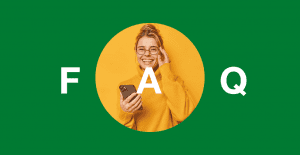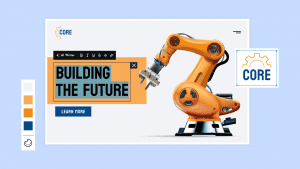Key takeaways:
- Good website content is clear, useful, and built to drive action.
- Each page on your site should serve a purpose, from building trust to driving clicks. Structure, tone, and visuals all matter.
- Content that’s clean, keyword-smart, and consistently updated keeps visitors engaged and search engines paying attention.
You’ve secured your domain and picked a design for your website. But before you hit Publish, pause and ask yourself: do you really know what your website content needs to say?
A homepage isn’t enough. Neither is a contact page or an “About” section written in a rush. Good website content connects with your target audience, proves your value, and turns site visitors into buyers.
This guide breaks down core content ideas and offers insights on crafting effective product pages, blog posts, and customer testimonials to help boost your conversion rate.
But before you dive in, it helps to understand the difference between web content and web copy. Each plays a specific role and mixing them up can cost you conversions.
Web content vs. web copy
Not all words on your site do the same job. What you say matters, but how you say it drives results. That’s why knowing the difference between web content and web copy is key to a smart website content strategy.
Web content is designed to educate, inform, or encourage readers to explore. It includes longer-form material like blog posts, articles, FAQs, and resources that guide potential customers through multiple stages of their journey.
Web copy, on the other hand, is tighter and more action-focused. It appears in headlines, banners, product descriptions, or CTAs, where you need to drive quick decisions like signing up or making a purchase.
Both are equally important. One builds connection. The other drives action. When used with intention, create a website that effectively engages your audience and achieves your goals.
What makes website content good
Clarity beats cleverness. While cleverness entertains, clarity converts. Well-written content speaks with direction and purpose, and here are the key qualities to nail:
- Clear and easy to read
- Audience-relevant
- Helpful and informative
- Action-driven (includes CTA)
- SEO-friendly
- Consistent in voice and tone
- Visually engaging
Clear and easy to read
To create top-notch content, write for your buyer personas. Use short sentences, plain language, and bullet points to make info digestible. Then, incorporate bold headings and a tidy layout to help readers stay on track, even on mobile.
Audience-relevant
Creating content that matches your target audience’s intent is key to getting results. Think about who they are, what they care about, and how they prefer to be addressed. When your written content feels personal and meets real needs, it keeps readers engaged and makes your content relevant at every step.
Helpful and informative
When you write content for your site, focus on usefulness. Add checklists, how-to guides, or downloadable content that solves real problems. Helpful content earns trust and prompts visitors to take action.
Action-driven (includes CTA)
Every website needs a clear call to action. Otherwise, visitors won’t know what to do next. Whether it’s “Buy now,” “Download the guide,” or “Subscribe,” your CTA should be easy to spot and makes sense in the context of your page. Action-focused content gives each section a goal, helping to turn casual clicks into meaningful engagement.
SEO-friendly
Search engine optimization is your behind-the-scenes power tool. Start with solid keyword research so your pages show up for the right searches. Check out competitor sites to spot gaps you can close. Then boost visibility by adding solid meta tags, a clear title tag, and helpful alt tags that make your content easier to find for both people and search engines.
Consistent in voice and tone
To write content that connects, your voice needs to stay consistent across all touchpoints. Whether it’s homepage copy or long-form content, your tone should reflect your brand personality—professional, friendly, or bold. Also, use an active voice to sound clear and confident.
Visually engaging
Keep people engaged with content that’s organized and skimmable, and visually appealing. Great content ideas don’t belong in plain text alone. They deserve visual assets to make them stand out. In content writing, things like images, videos, and icons help break up walls of text, highlight what matters, and keep readers engaged.
Key types of web content search engines love
Every page on your site has a job. Search engines pay attention, and so do your site visitors. From your homepage to your blog, each piece of website content plays a role in helping people discover your site and understand what it offers. Here’s what to focus on and why it matters:
Homepage
What it is: Your digital storefront
Why it matters: Search engines treat your homepage as a key signal for your site’s purpose. Therefore, keep your homepage simple and clear so users and search engines can navigate it easily.
Quick tips:
- Start strong with a clear headline that tells visitors what to expect.
- Drop links to must-see pages like “Services” or “Contact” page.
- Keep your tone consistent so it matches your brand’s personality.
- Break content into sections to help readers find what they need faster.
Bonus insight: Use scroll maps to find out where visitors lose interest on your homepage. This helps you spot weak points in the layout and adjust them to hold attention longer.
About page
What it is: A place to introduce your brand and show your authenticity
Why it matters: This page can attract branded searches and backlinks and helps establish authority with search engines.
Quick tips:
- Share your mission, values, and team.
- Keep tone authentic but structured.
- Link to other parts of your website.
- Include relevant information and keywords naturally.
Bonus insight: Ask someone outside your team to read your About page. If it feels genuine and easy to follow, you’re on the right track.
Blog posts
What it is: A space to educate, inspire, and connect through helpful tips, storytelling, or fresh ideas. A strong blog post builds loyalty, boosts visibility in search results, and reinforces your authority.
Why it matters: Publishing good content consistently can grow your audience and support your overall content marketing goals. It also backs your content marketing team with one place for insights, updates, and content planning.
Quick tips:
- Start strong with an engaging hook and a compelling headline.
- Prove your point with real stats or examples.
- Keep the journey going with links to blog articles or next steps.
- Bring in a content writer if you need help producing quality posts.
Bonus insight: Great content takes time. Focus on one clear message per post so your readers don’t get lost.
Product pages
What it is: A space to show what your product or service is all about. It helps potential buyers decide if your offer is worth their time and money.
Why it matters: Well-structured product pages support online marketing by giving your target audience the clarity they need. For a small business, that first impression can seal or lose the deal.
Quick tips:
- Clearly explain the product’s features and benefits, highlighting its value proposition.
- Show real details with sharp, high-quality photos.
- Incorporate customer reviews to build trust and social proof.
- Use direct CTAs like “Add to Cart” or “Buy Now” to nudge decisions.
Bonus insight: Use the same words your customers use when they describe your product. It keeps your message clear and can help your page show up better in search results.
FAQ section
What it is: A handy part of your website that answers common questions in a clear, straightforward manner.
Why it matters: A well-built FAQ section can lift your rankings in search results, improve the experience for your visitors, and help people find what they need faster.
Quick tips:
- Write clear answers using short, simple sentences.
- Link to other relevant pages for deeper info.
- Refresh your FAQ based on actual user feedback or search queries to improve relevance and SEO.
Bonus insight: Cover real user queries in your FAQ section to improve visibility in search results.
Landing pages
What it is: A focused page designed for creating content that grabs your readers’ attention and guides them toward a single action, like signing up, purchasing, or contacting you.
Why it matters: A strong landing page can directly boost your conversion rate by keeping visitors engaged and moving them closer to your goal.
Quick tips:
- Focus your message on one clear outcome.
- Use action-driven CTAs like “Sign Up Free” or “Claim Your Offer.”
- Highlight what’s in it for the visitor and why it’s worth acting now.
Bonus insight: Clean design and tight copy make a difference. Avoid clutter and make sure every section works toward a single goal.
Testimonial page
What it is: A page dedicated to customer testimonials. It features firsthand experiences to prove your credibility and guide potential customers toward a decision.
Why it matters: Testimonials work because people trust other customers. They help encourage readers to act by sharing clear, relatable proof that your business delivers.
Quick tips:
- Let real voices back your reputation.
- Include photos or short videos to give each story more impact.
- Showcase different types of customers so your message speaks to a wider crowd.
Bonus insight: Always get permission before publishing customer testimonials. A quick thank-you or perk can go a long way.
Quick checklist to write high-quality content
Here’s a quick checklist to help you write content like a pro:
- Know what your audience needs. Begin with keyword and user intent research.
- Plan first. Outline your ideas before you write.
- Keep it clean. Use short paragraphs and plain language for readability.
- Refresh often. Check for outdated information, broken links, or weak headlines.
- Make it visual. Let graphics and videos back up your message and hold attention.
- Guide your readers. Use strong headers, internal links, and clear CTAs.
- Polish it up. Review tone, grammar, structure, and reorganize for scannability.
Drive your website content forward with Network Solutions
Great content builds trust, drives clicks and keeps people engaged. But staying relevant takes more than a one-time effort. You need to keep things fresh and useful.
No time to build it yourself? Network Solutions gives you the tools to publish faster and smarter. But don’t go live half-ready. Build your website—without the headaches. Let our pros handle the design and copy so you launch with impact.
Frequently asked questions
A content page is a page built to inform, explain, or guide your site visitors on a certain topic. This can include blog posts, product details, or FAQs. It usually focuses on a single topic and features written content, visuals, or both. These pages help users learn more, take action, or decide if your business is right for them.
A content-rich website offers helpful blogs, videos, images, and tools that give users real value. It answers their questions, builds trust through valuable and well-researched content, and keeps them engaged with high-quality, informative, and interactive formats. This encourages visitors to stay longer and return more often.
Effective content comes from knowing your audience and setting clear goals. Focus on what they need and how your content can help. Use a clear structure, simple language, and strong visuals. Prioritize value, readability, and SEO so your message is easy to find and act on.
For most businesses, the homepage is the most important page. It’s often the first thing visitors see, and it helps them understand what your site is about. A strong homepage makes a good first impression, guides people to other pages, and supports your SEO and conversion goals.




